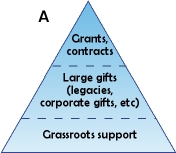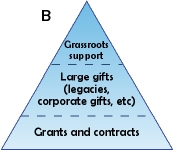Progression Tracker
Do You Need a Funding Plan?
Introduction to the Six Steps
Step 1: Establish Priorities
Step 2: Assess Capacity
Step 3: Set Fundraising Goals
Step 4: Identify Funding Sources
Step 5: Evaluate & Select Funding Sources
- Fundraising Environment
- Diversification
- Estimated Returns
- Sustainability
- Key Evaluation Questions
Final Quiz
Sample Finance Plans
List of Case Studies
References & Additional Resources
Step 5 (continued). Sustainability
In choosing your funding sources, it is important to remember that they are not all equal. Particularly because your organization faces time and resource constraints, it is important to target resources that will promote the sustainability of your organization and maximize funding year to year. Before we go further, let's find out how much you know about fundraising by looking at two fundraising models:
Which of the following is a more stable fundraising model?
(See correct answer below.)
The key here is that while government and foundation grants are important sources of funding for many types of projects, donations from individuals, local industries, and private businesses are especially important. Although they may initially require a higher investment in staff time and resources, these private sources of funding should be the base of your financial support because they are more stable and have fewer restrictions than grants. In the long term, they will actually save staff time in researching options. Grants are unpredictable; their availability can change due economic conditions and changes in political priorities (see figure below). Further, grant money is typically restricted to specific projects.

Compare that graph to how watershed groups across the country are currently receiving their funds (see figure below which depicts results of a 2005 River Network Study). Individual contributions account for less than half of their funding. Clearly, a great opportunity exists for organizations to improve their funding stability and flexibility long-term.
Sources of Income for Nonprofit Watershed Organizations (2005)

Citation: See Resources, Works Cited #29
 Correct. Model A is More Stable! Watershed organizations should pursue a variety of funding sources to support project and operating expenses.
Correct. Model A is More Stable! Watershed organizations should pursue a variety of funding sources to support project and operating expenses.
While government and foundation grants are important sources of funding for many types of projects, grassroots support (donations from individuals, local industries, and private businesses) is especially important.
These private sources of funding should be the base of your financial support, because they are more stable and have fewer restrictions than grants. Grants are unpredictable; their availability can change can due economic conditions and changes in political priorities. Grant money is typically restricted to specific projects.
Your sustainable fundraising plan should outline strategies to build a strong base of grassroots support. A few potential sources are:
- Donations of cash through membership, special appeals, major donor campaigns, and bequests
- Donations of goods and services by businesses
- Reductions in the cost of materials purchased from local businesses that support watershed projects or fundraisers
Incorrect. Model A is More Stable! Not Model B.
![[logo] US EPA](https://www.epa.gov/epafiles/images/logo_epaseal.gif)
